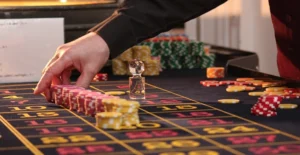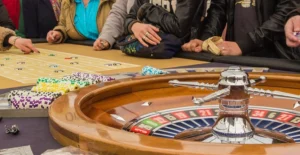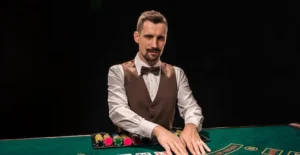Playing in a baccarat tournament can be a really big deal. The top prize in a major event might be worth millions of dollars. Over the next few articles, our casino game expert, Andrew Scott, will show you how to win big in these tournaments. When you play regular baccarat at a casino, you are just trying to guess if the banker or player will win and bet on that. You want to win real money. But the funny thing about winning a baccarat tournament is that you don’t always need to win chips or have a huge stack. You just need to do better than everyone else. This means winning more or losing less than your opponents.
Key Takeaways
- Baccarat tournaments are about outperforming opponents, not just accumulating chips.
- Money management is crucial; know your chip count and your opponents’.
- Betting order is important, especially the ‘first bet’ marker system.
- Strategic use of ‘secret bets’ can provide a significant advantage.
- Understanding card tracking and shoe penetration helps in planning late-game strategy.
What Is a Baccarat Tournament? – Format & Rules Overview
So, you’re curious about baccarat tournaments? Let’s break it down. Forget the usual casino game against the house; this is abaccarat competition rules showdown against other players. It’s less about having the best hand every round and more about outmaneuvering your opponents over the long haul. The goal isn’t necessarily to amass the most chips in every round, but to finish with more than the others.
Think of it like a poker tournament, but with baccarat rules. You’re not just playing the cards; you’re playing the people.
- Players start with a set amount of chips.
- Multiple rounds are played, with a specific number of hands per round.
- The field is gradually narrowed as players are eliminated based on their chip count.
- The last players standing (or those with the most chips at the end) win prizes.
Baccarat tournaments add a layer of complexity beyond simply betting on Player, Banker, or Tie. It’s about managing your bankroll, observing your opponents, and making strategic bets to maximize your chances of advancing.
Understanding the format is key to developing a solid baccarat tournament strategy. It’s not just about knowing how to play baccarat; it’s about knowing how to play tournament baccarat. This baccarat tournament guide will help you understand the nuances of this exciting game. Thebaccarat tournament tips are essential for success. Ultimately,winning baccarat tournaments requires a blend of skill, strategy, and a bit of luck.
Tournament Rules Explained
Baccarat tournaments have specific rules that differ from standard casino baccarat. Understanding these rules is key to developing a winning strategy. It’s not just about having the most chips; it’s about strategically outmaneuvering your opponents.
- Betting Order: Players bet in a strict order, similar to poker. This order is crucial because it allows you to see your opponents’ bets before making your own. This information is vital for making informed decisions.
- Minimum and Maximum Bets: Tournaments usually have minimum and maximum bet limits. These limits can affect your strategy, especially when trying to catch up or maintain a lead.
- Tie Bets: While generally avoided in standard baccarat, tie bets can be strategically used in tournaments, especially in the final hands. More on that later.
The goal in a baccarat tournament isn’t necessarily to accumulate the most chips overall, but to have more chips than your opponents at the end of each round and, ultimately, at the end of the tournament.
- Secret Bets: Some tournaments offer a limited number of secret bets. These allow you to place a bet without revealing it to other players until after they have bet. This can negate the disadvantage of betting early in a round.
- Pass Cards: Some tournaments use pass cards, which allow you to bet zero on a hand. These can be useful in certain situations, especially towards the end of the tournament.
- Advancing: Players advance through rounds based on their chip count relative to other players at their table. The specific rules for advancing can vary from tournament to tournament.
Understanding Baccarat Basics: Player vs. Banker vs. Tie Bets

Baccarat is known for its simplicity, and a big part of that is understanding the three basic bets you can make: Player, Banker, and Tie. It’s important to know the ins and outs of each, especially when playing in a tournament setting where every decision counts. Let’s break them down.
The goal in Baccarat is to predict which hand, Player or Banker, will have a point total closest to 9.
- Cards 2 through 9 are worth their face value.
- 10s and face cards (Jack, Queen, King) are worth 0.
- Aces are worth 1.
- If the total is more than 9, only the last digit counts (e.g., a hand of 7 and 8 totals 15, which becomes 5).
It’s worth noting that the terms ‘Player’ and ‘Banker’ don’t refer to you or the house. They’re just names for the two hands being dealt. You can bet on either one, regardless of your position at the table.
Player Bet
This is a bet that the Player’s hand will have a higher total than the Banker’s hand. If you win, you get paid out at 1:1 (even money). The Player’s bet has a slightly lower chance of winning compared to the Banker bet.
Banker Bet
Betting on the Banker means you’re predicting that the Banker’s hand will be closer to 9. This bet has a slightly higher probability of winning than the Player bet. However, most casinos charge a commission (usually 5%) on winning Banker bets. Even with the commission, the Banker bet is often considered the slightly better bet in the long run. The house edge of the Banker’s bet is 1.06 percent.
Tie Bet
A Tie bet is a wager that both the Player’s and Banker’s hands will have the same total. This is the least likely outcome, and therefore it offers the highest payout, usually 8:1 or 9:1, depending on the casino. While the payout is tempting, the Tie bet has a significantly higher house edge, making it a riskier choice. The house edge of the Tie bet is much higher than the other two bets.
Here’s a quick comparison:
| Bet | Payout | House Edge (approx.) |
| Player | 1:1 | 1.24% |
| Banker | 1:1 (minus 5% commission) | 1.06% |
| Tie | 8:1 or 9:1 | 14.4% (with 8:1 payout) |
In tournament play, understanding these probabilities and payouts is key to making informed decisions about your baccarat strategy. While the Banker bet might seem like the obvious choice, the commission can eat into your winnings, and the Tie bet, while risky, can offer a big boost if it hits. Knowing when to deviate from the default strategy is what separates the good players from the great ones.
Tournament Betting Order & ‘First Bet’ Marker System
In baccarat tournaments, the order in which players bet is super important. It’s not just about luck; it’s about strategy. The betting order gives some players an edge over others, so understanding how it works is key to doing well.
Understanding the ‘First Bet’ Marker
Just like in poker, baccarat tournaments use a marker to show who bets first. Think of it like the dealer button in poker, but instead of indicating the last person to bet, it shows the first person. This marker moves after each hand, usually in a counter-clockwise direction around the table, ensuring everyone gets a chance to bet in different positions.
- The marker moves to the next player after each hand.
- This ensures everyone gets a fair shot at betting in different positions.
- A complete rotation of the marker is called a ‘lap’ or ‘orbit’.
Occasionally, a tournament might have a rule where the ‘first bet’ marker doesn’t move after a tie. Honestly, this doesn’t change things much since ties don’t happen that often.
The Advantage of Betting Position
Betting after another player gives you a significant advantage. You get to see what they do before you make your move. On the flip side, if someone bets after you, they have the advantage. Players to your left usually bet before you, while those to your right bet after you. This means a smart banking strategy is key.
Focusing on the Right Opponents
Pay more attention to the players on your right. They have a bigger impact on your game because they bet after you. Being behind in chips to someone on your right is a bigger problem than being behind someone on your left, especially if they know how to use their position to their advantage.
Money & Chip Management Tips for Tournament Play
Tournament baccarat isn’t just about knowing the rules; it’s about mastering your bankroll. You’re not trying to amass the most chips overall; you’re trying to have more than your opponents at the right time. This requires a different mindset than regular casino baccarat.
Understanding Your Chip Stack Relative to Others
It’s not just about how many chips you have, but how your stack compares to the other players. Knowing where you stand is half the battle. Are you ahead, behind, or neck-and-neck with your closest rivals? This information dictates your betting strategy.
Conservative vs. Aggressive Play
Your chip management should shift depending on your position in the tournament. Early on, a more conservative approach might be wise to avoid early elimination. As the tournament progresses, you might need to become more aggressive to catch up or maintain your lead. Think of it like sustained baccarat play – it’s a marathon, not a sprint.
Bankroll Preservation
- Avoid unnecessary risks early in the tournament.
- Don’t chase losses; stick to your planned strategy.
- Be prepared to adjust your betting size based on your stack and the stage of the tournament.
Maximizing Opportunities
- Identify situations where a slightly larger bet can significantly impact your position.
- Be willing to take calculated risks when necessary to overtake opponents.
- Don’t be afraid to bet big when you have a positional advantage.
Effective chip management in baccarat tournaments is about understanding the dynamics of the game and adapting your strategy accordingly. It’s not just about winning every hand; it’s about making smart decisions that maximize your chances of finishing ahead of your opponents.
Avoiding Common Pitfalls
- Don’t get emotional and make rash decisions.
- Avoid betting too much of your stack on a single hand, especially early on.
- Be aware of the table limits and how they might affect your strategy.
Tracking Hands & Shoe Penetration Strategy
In baccarat tournaments, keeping track of the cards dealt and estimating how far into the shoe you are can give you a significant edge. It’s like knowing how much time is left in a basketball game – you can adjust your strategy accordingly. The average baccarat hand uses about 5 cards, so you can use this to estimate the number of hands remaining.
Let’s say you’re playing with an eight-deck shoe. A standard eight-deck shoe has 416 cards (8 decks x 52 cards/deck). If the dealer burns 10 cards at the beginning and the cut card is placed 10 cards from the end, that leaves 396 cards in play. Knowing each hand averages 5 cards, you can estimate that around 80 hands will be dealt before the cut card appears. This information is useful for planning your bets, especially towards the end of the shoe.
Knowing how many hands are left allows you to anticipate when key betting decisions will occur. This is especially important in tournaments where the order of betting can significantly impact your strategy.
Here are some things to consider:
- Card Counting (Simplified): While not as effective as in blackjack, keeping a basic count of high and low cards can give you a slight edge. Focus on tracking Aces and 10s, as they influence the likelihood of natural wins (hands totaling 8 or 9).
- Burn Cards: Always pay attention to the burn cards at the start of the shoe. These cards are removed from play and can slightly alter the odds.
- Dealer Tendencies: Observe the dealer. Do they shuffle thoroughly? Do they have any subtle tells that might indicate the composition of the shoe?
Understanding baccarat hands and shoe penetration can help you make more informed decisions and potentially gain an advantage over your opponents.
Smart Banking Strategy
Winning at baccarat tournaments isn’t just about getting lucky; it’s about smart money management. You need to know how much you have, how much your opponents have, and make bets that give you the best chance of finishing with more chips than them. It doesn’t matter if you have a lot or a little; the key is the difference between your stack and theirs.
Winning a baccarat tournament is all about money management. You need to know how much you’ve got, how much they’ve got, and make bets that give you the biggest chance of finishing up with more chips than the other players. You don’t care whether you have a lot of chips or hardly any chips; the key thing here is the difference between your stack and their stacks.
Here are some things to keep in mind:
- Know the default bet. Banker is a slightly better bet than player. If you don’t have a reason to bet one way or the other, your default bet is banker. However, be ready to change that default for different reasons.
- Only bet the tie on the last hand. The tie has a high house advantage. It’s best to avoid betting on the tie until the last hand, where you’ll almost always bet the maximum on the tie. This is because, on the other hand, the house edge isn’t as important. Instead, the goal is to beat your opponent.
- Understand the ‘first bet’ marker. Baccarat tournaments use a ‘first bet’ marker because betting order is important. This is like a dealer button in poker, but it shows the first person to bet. The marker moves to the next player after each hand, so everyone gets a fair share of the different betting positions. This is important for tournament betting strategy.
Secret Bets & Pass Cards
Okay, so let’s talk about secret bets and pass cards in baccarat tournaments. These can be game-changers if you know how to use them right. It’s not just about blindly throwing them out there; it’s about timing and strategy.
Secret Bets: The Ultimate Advantage
Secret bets are gold. They let you bet after everyone else has placed their bets, which is a HUGE advantage. Think of it like getting to see everyone’s cards before you make your move in poker. Most tournaments give you a limited number of these, so you gotta use them wisely. Don’t waste them when you’re already betting late in a round. Save them for when you’re stuck betting first or early, especially against tough opponents. And ALWAYS keep one for the final hand – it could be the difference between winning and going home.
Pass Cards: When to Hold Back
Pass cards are different. They let you bet zero on a hand. Honestly, they’re not as exciting as secret bets. Betting zero isn’t that different from betting the minimum, but they can be useful in a pinch. I’d recommend saving them for the very end of the tournament. They might come in handy on the last few hands when you’re trying to manage your chips or avoid a risky bet.
Just a heads up: if you’re using a pass card with a secret bet, make sure you don’t accidentally hand the pass card in with your secret bet slip. That’ll give your opponents a pretty good idea of what you’re up to.
Combining Secret Bets and Pass Cards
Can you use a pass card with a secret bet? Usually, yes. But think about why you’d want to. Maybe you’re in a spot where you don’t want to risk any chips, but you also want to see what everyone else bets. It’s a niche situation, but it could happen. Just remember to keep those cards separate when you hand them in.
So, to recap:
- Secret bets are your best friend – use them strategically when you have to bet early.
- Pass cards are less powerful, but can be useful for damage control at the end.
- Don’t mix them up when you’re handing them in!
Understanding how to use these tools can improve your baccarat strategy and give you an edge in tournament play.
Tournament Strategy Across Stages
Baccarat tournament strategy isn’t a one-size-fits-all deal. What works in the early rounds might be a disaster later on. You’ve got to adapt your approach as the tournament progresses. It’s like a poker tournament; you wouldn’t play the same way at the start as you would at the final table, right?
Early Stage: Conservative Play and Information Gathering
In the beginning, it’s all about survival and gathering intel. Don’t go wild with huge bets. Focus on making smart, calculated wagers to stay in the game. This is the time to observe your opponents. See how they bet, how risky they are, and if they seem to have any tells. You’re building a profile of each player, which will be useful later.
- Keep bets relatively small and consistent.
- Pay attention to the betting patterns of other players.
- Avoid unnecessary risks.
Middle Stage: Adjusting to the Field
As players get eliminated, the dynamics shift. You should have a decent idea of where you stand with the other players. This is where you start adjusting your strategy based on your chip stack and the behavior of your opponents. If you’re near the top, you can afford to be a bit more aggressive. If you’re near the bottom, you might need to take some calculated risks to catch up. Remember, winning a baccarat tournament is about relative chip position, not necessarily having the most chips.
- Increase bet sizes if you have a chip lead.
- Consider riskier bets if you’re behind.
- Be aware of the changing dynamics as players are eliminated.
Late Stage: Aggression and Calculated Risks
The final rounds are where things get intense. This is where you need to be aggressive and willing to take calculated risks. You’re not just trying to survive anymore; you’re trying to win. Pay close attention to the betting order and use that to your advantage. If you’re betting last, you have a huge edge because you can see what everyone else has bet. Use your secret bets wisely, saving at least one for the final hand. The goal is to maximize your chances of finishing with more chips than your opponents, even if it means making some unconventional plays. Understanding the Three Card Baccarat rules is also important.
- Maximize bet sizes to gain an advantage.
- Use the betting order to your advantage.
- Save secret bets for crucial moments, especially the final hand.
It’s important to remember that tournament baccarat is different from regular baccarat. You’re not just trying to win individual hands; you’re trying to outmaneuver your opponents and finish with more chips than they do. This requires a different mindset and a willingness to adapt your strategy as the tournament progresses.
Positional Play
Positional play in baccarat tournaments is all about understanding where you sit about the ‘first bet’ marker. This marker dictates the order in which players must bet, and your position relative to it can significantly impact your strategy. Having the advantage of betting after other players provides valuable information and control.
Think of it like this: in poker, you want to act last to see what everyone else does first. The same principle applies here, although the advantage isn’t quite as pronounced.
- Betting Order Matters: The closer you are to the end of the betting order, the more information you have about your opponents’ bets. This allows you to make more informed decisions about your bets.
- Advantage on Your Right: Players to your right who bet before you are at a disadvantage. You can use their bets to gauge their chip stacks and strategies.
- Disadvantage on Your Left: Conversely, players to your left who bet after you have an advantage. Be wary of their potential to exploit your bets.
It’s important to remember that the ‘first bet’ marker moves around the table after each hand. This means that your position will change throughout the tournament, and you’ll need to adjust your strategy accordingly. Understanding the Baccarat Martingale and how it affects your opponents’ betting patterns is also crucial.
Understanding the ‘First Bet’ Marker
The ‘first bet’ marker is similar to the dealer button in poker. It indicates who bets first on each hand. The marker moves counter-clockwise after each hand, ensuring everyone gets a turn to bet in each position. Knowing where the marker starts and tracking its movement is key to understanding positional advantages.
Exploiting Positional Advantages
If you’re betting late in the order, you can use the information from earlier bets to your advantage. For example, if a player with a large chip stack bets aggressively, you might choose to play more conservatively to avoid a confrontation. Conversely, if a player with a small chip stack bets conservatively, you might choose to bet aggressively to try and knock them out of the tournament.
Mitigating Positional Disadvantages
If you’re betting early in the order, you’re at a disadvantage because you have less information. In this case, it’s important to be more cautious and avoid making overly aggressive bets. You might also consider using secret bets (if available) to conceal your intentions and gain an advantage. Remember, the goal is to minimize your risk and maximize your chances of surviving to the later stages of the tournament.
Tactical Use of Tie Bet on Final Hands Only
It’s generally accepted that the tie bet in baccarat is something to avoid. The house edge is pretty high, making it a less-than-ideal choice for consistent betting. However, tournaments throw a wrench into typical baccarat strategy. The final hand changes everything, and the tie bet can become a powerful tool.
Why? Because at that point, your primary goal shifts from maximizing your chip count over the long run to specifically trying to beat your opponent. The house edge becomes less important than the potential to swing the game in your favor.
Consider these points:
- The tie bet offers a significant payout (usually 8:1), which can be enough to overtake a marginal lead.
- If you’re significantly behind, a tie bet might be your only realistic chance to catch up.
- The psychology of the tie bet can influence your opponent’s decisions.
Betting on the tie on the last hand is a high-risk, high-reward move. It’s not about playing the odds; it’s about playing your opponent and the specific tournament situation. It’s a gamble, sure, but sometimes a calculated gamble is exactly what you need to win. Remember to consider the face-up pai gow poker strategy as well.
Think of it this way: earlier in the tournament, you’re building a foundation. On the final hand, you’re either defending your lead with a strategic tie bet or making a desperate attempt to snatch victory from the jaws of defeat. It’s all about context.
Advancing Through Rounds
Baccarat tournaments aren’t just about winning every hand; it’s about strategically managing your chips to outlast and outmaneuver your opponents. The structure of a tournament, with its multiple rounds, demands a different approach than a standard casino game. You’re not just aiming to accumulate the most chips overall, but to consistently stay ahead of the elimination line. This means understanding how the field narrows, how chip stacks compare, and adjusting your play accordingly.
The key is to survive and advance, even if it means making calculated risks or playing conservatively at times.
Think of it like a marathon, not a sprint. Conserving your resources and knowing when to push is crucial. The early rounds might be about gathering information and establishing a position, while later rounds demand more aggressive tactics to secure your spot.
It’s important to remember that your chip stack is relative. Having a million chips doesn’t guarantee victory if everyone else has two million. Focus on your position relative to the other players, especially those near the cut-off line for advancing.
Here’s what to keep in mind as you progress through the tournament:
- Track your opponents’ stacks: Knowing where you stand relative to the competition is vital. Pay attention to who’s accumulating chips and who’s struggling.
- Adjust your betting strategy: As the rounds progress, you’ll need to adapt your betting style based on your chip position and the number of players remaining. Early rounds might call for conservative play, while later rounds might require more aggressive bets.
- Be aware of the elimination threshold: Understand how many players will be eliminated at the end of each round. This will influence your risk tolerance and betting decisions.
Top Tournament Tips
Winning a baccarat tournament isn’t just about having the most chips at any given moment; it’s about strategically managing your resources and outmaneuvering your opponents. It’s a different beast than regular casino baccarat, where you’re simply trying to win money hand by hand. Here are some key tips to keep in mind:
Money Management is Key
Effective money management is the cornerstone of baccarat tournament success. You need to be acutely aware of your chip stack relative to your opponents’ stacks. The goal isn’t necessarily to amass the largest stack, but to finish with more than your rivals. Don’t manage your bankroll carelessly.
Betting Order Awareness
Betting order is incredibly important. Unlike standard baccarat, where the order is irrelevant, in a tournament, knowing when you bet against your opponents gives you a significant advantage. If you can see how much and on what your opponent bets, you gain valuable information to inform your own decision. This is why the order is strictly enforced, similar to poker.
Strategic Use of Secret Bets
Many baccarat tournaments incorporate secret bets. These are powerful tools that allow you to negate the disadvantage of betting early in a round. Since the bet is concealed until after everyone else has wagered, it’s like betting last, regardless of your actual position. Always save at least one secret bet for the final hand. If you have multiple, consider using them when you’re forced to bet early against key opponents in the last few rounds.
Pass cards, which allow you to bet zero on a hand, are less valuable than secret bets. Save them for the very end, as they might be useful in specific last-minute scenarios. Be careful not to confuse them with secret bets and accidentally submit one with your secret wager.
Understand the Default Bet
Even with the commission, the banker bet is slightly more favorable than the player bet. In the absence of any specific reason to bet otherwise, the banker should be your default choice. However, be prepared to deviate from this default based on tournament dynamics and specific rules, such as variations in commission or payouts.
Track Hands and Shoe Penetration
Knowing how many hands have been played and how many remain in the shoe is crucial. A baccarat hand uses an average of approximately five cards. By tracking the hands, you can estimate how close you are to the end of the shoe and anticipate who will be betting early or late in the final rounds. If you have the opportunity to choose your seat, consider which position is likely to be last on the final hand – this is the most advantageous spot.
Tie Bet Strategy
Avoid betting on the tie except for the final hand. The tie bet has a high house edge, and overusing it will quickly deplete your stack. However, on the other hand, the tie bet becomes a critical strategic tool for maximizing your chances of beating your opponent, even if it means risking a larger portion of your chips.
Frequently Asked Questions
What are the basic rules of Baccarat?
Baccarat is a card game where players bet on which of two hands, the ‘Player’ or ‘Banker,’ will have a total closer to nine. Cards 2 through 9 are worth their face value, 10s and face cards (King, Queen, Jack) are worth zero, and Aces are worth one. If a hand’s total goes over nine, only the last digit counts (for example, 7 + 6 = 13 becomes 3).
Are there any special techniques for playing Baccarat?
While luck plays a big part in Baccarat, players can use strategies like tracking card patterns or using betting systems. However, no special technique is required to play and win.
What is the objective in Baccarat?
The main goal in Baccarat is to bet on the hand that will be closest to nine. You can bet on the ‘Player’ hand, the ‘Banker’ hand, or on a ‘Tie’ between them. The hand with the highest total value wins.
How can one play Baccarat online?
To play Baccarat online, you need to find a trusted online casino that offers the game. After creating an account and adding money, you can go to the Baccarat section to start playing.
Is Baccarat an easy game to learn?
Yes, Baccarat is known for being easy to learn. It has only a few betting choices, and its rules are simple, so even new players can quickly understand how to play.
Which is the best bet to make in Baccarat?
In Baccarat, the ‘Banker’ bet is generally considered the best option. Even with a small commission often charged by casinos, the ‘Banker’ bet has a lower house advantage (1.06%) compared to the ‘Player’ bet (1.24%). The ‘Tie’ bet has a much higher house advantage and is rarely a good strategic choice.
How does playing in a baccarat tournament differ from regular baccarat?
A baccarat tournament differs from regular play because your goal is to have more chips than your opponents, not necessarily to accumulate the most chips overall. Success depends on managing your chips effectively and making bets that give you an advantage over other players.
Why is betting order important in a baccarat tournament?
In a baccarat tournament, the order in which players place their bets is very important. Knowing what your opponents have bet or how much they have wagered can give you valuable information to guide your betting strategy.
Daniel Chase is a seasoned casino analyst and iGaming writer with over 10 years of experience in the online gambling industry. He specializes in game strategy, casino odds, and player-focused reviews. Daniel is passionate about helping players make smarter decisions through transparency, real data, and honest insight.












